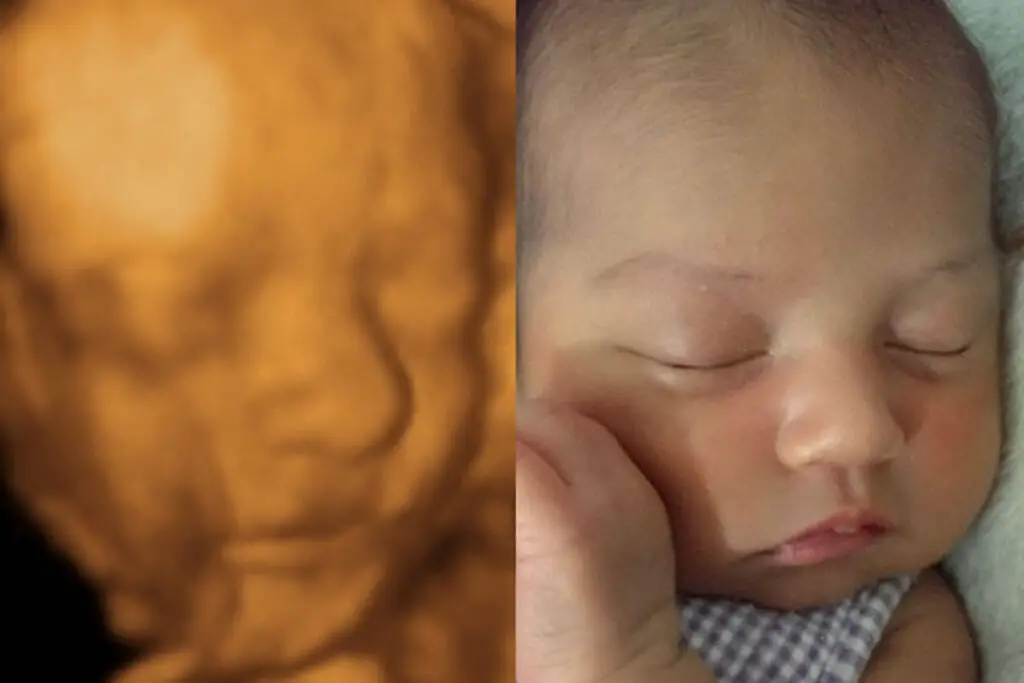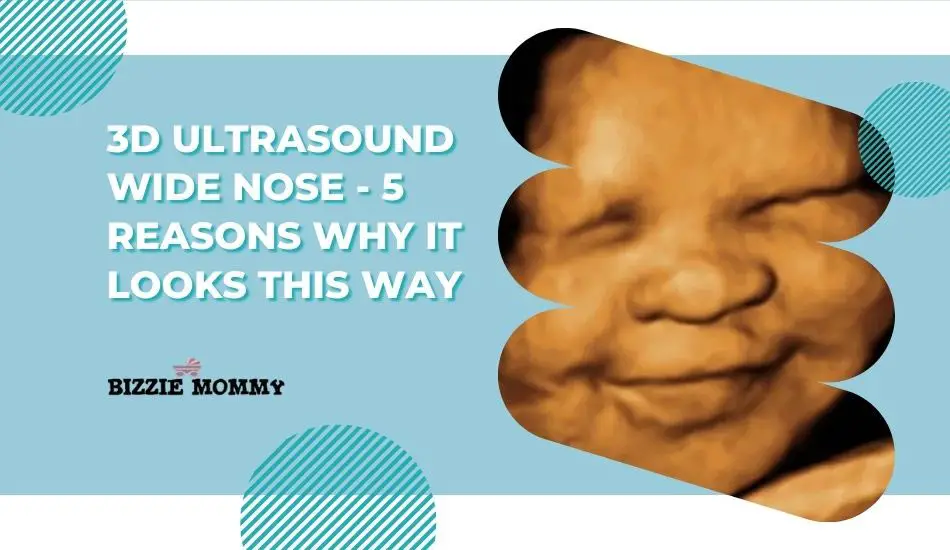Ultrasound pictures are not the exact image of the baby’s appearance. The primary purpose of ultrasound pictures is to keep the baby’s development in check as the pregnancy progresses. It is natural to feel curious and worried as a parent, especially as a mother.
There are a few simple reasons your baby’s nose may look big in the ultrasound, and none of them are anything to worry about.
1. The Sound Waves Are Distorted
Typically, 3D and 4D ultrasounds are preferred over the conventional 2D ultrasound as they offer images with greater detail. With 3D or 4D imaging, we can view the actual physical features of the baby. All ultrasound types generate images using sound waves.
The general mechanism of ultrasound is that the internal organs and bodily fluids bounce off sound waves, which a computer then uses to create two-dimensional images. Many 2D images are captured from different angles and then joined to form 3D images of the baby’s features. These 2D images are not high quality and often quite distorted. This is why the features present in the ultrasound are often much different from the actual features. This could be one reason the baby’s nose appears enormous in the ultrasound.
2. The Baby is Still Developing
Very little fat on the baby’s face during gestation can distort the actual features. Since there is not much covering the bones, this can make certain features look different from the way they will at birth. In particular, the nose does not have much fat to begin with, and due to the curled-up fetal position, the nose can look more flared.
3. The Baby’s Face is Turned
2D imaging works when the sound waves are transmitted through the belly and they capture the surface images. If the baby is facing the uterine wall or has his or her face turned away from the belly, the 2D imaging will only get three-fourths, half, or even just a quarter of the actual facial features. This can be another cause of the ultrasound image not being accurate, and the baby can appear to have a wide nose.
4. The Baby’s Nose is Covered
The baby is in a curled-up position in the womb, as there is not enough space for it to spread about as it likes. The uterine wall is a muscle that develops and expands as the baby grows. As the uterine space gets constrained during the seventh month of pregnancy, your baby will make minor adjustments such as repositioning their knees and elbows.
Your baby will probably snuggle up and hug their knees. This can lead to their foot or arm coming in front of their face. When a body part is in front of the baby’s head, it can lead to image distortion.
5. Baby Has a Big Soft Spot
Fontanels are two large soft patches on the top of the head that are present at birth. These soft areas are voids between the skull’s bones when bone growth is incomplete. This permits the skull to be shaped throughout the birth process. By two to three months, the smaller spot in the rear normally closes. Around eighteen months, the bigger spot in the front also closes. Until then, it pulsates and is generally somewhat depressed.
Soft areas are protected by a strong fibrous covering and can be touched lightly. You might not even see them, depending on how big or little your child’s spots are. These spots are also there during pregnancy and can be seen as large spots on the head of your child that sometimes slit downward, all the way to their nose. This can cause the nose to be pushed flat and hence, can distort the ultrasound of the nasal skeleton.
Are 3D Ultrasounds Accurate For Looks?

A 3D baby scan might make comprehending what you’re looking at simpler, and your kid will most likely appear like a newborn. The third dimension is created by combining many 2D photos collected at various angles, but the scanner does not capture a good read on some of the surfaces. Although a 3D scan is far more accurate than 2D, it is not like an actual camera and hence, will not give completely accurate results of the full-bodied image of the child.
Nose 3D Ultrasound vs Real Baby
You are not the first expecting parent who has noticed a large nose on the screen. When newborns’ nasal skeletons are observed on an ultrasound, they seem deformed. To produce a picture, 3D ultrasound employs sound waves and equipment that can interpret those vibrations. The two-dimensional pictures can only capture surface images and have the ultrasound technicians hunting the baby throughout the womb for complete body imaging.
The technician may acquire photos at three 90-degree planes using the 3D ultrasound. The instrument emits the waves and detects the bounce back. The waves are aimed at the infant from various angles. These waves must bounce off a variety of objects to generate a picture. The problem is that some of your baby’s characteristics are little and smooth, so the waves have nothing to bounce off of. Because there aren’t enough areas off which to ricochet, the technology compensates by widening smaller aspects.
When Does The Nose Fully Develop in a Fetus?
Your baby’s lower extremity buds adopt the form of paddles eight weeks into the pregnancy or six weeks following conception. There are already signs of fingers. Small swellings form around the future shell-shaped portions of your baby’s ears, and the eyes become visible. The nose and upper lip also develop at this time.
Does My Newborn Have A Big Nose?
Using the 3D ultrasound, the technician may take pictures in three 90-degree planes. The 3D ultrasound gadget sends out sound waves and monitors the reflected waves. The waves strike the newborn from various angles. To form an image, the waves must bounce off a number of things. However, since some of your baby’s body parts are small and flat, they leave nothing for the waves to bounce off of. Because of this, many features of your child are enlarged in the ultrasound. The enlarged aspect may make you question whether you’re going to have a kid with a huge nose, but this rarely occurs.
Will My Baby’s Nose Change After Birth?
There is a great deal of pressure in the womb, which might cause your baby’s nose to deform. Also, a baby’s nose may be pressed flat in the uterus. Moreover, the nose can sometimes be compressed during birth, but a baby’s body was designed to withstand such forces. While some infants might need a little more time, the baby’s nose is usually restored to normal after a week.
Babies’ noses change as they grow and mature. As your child develops into an adult, his or her nose will begin to develop. As time passes, everyone’s nose develops. These changes are caused by various factors, including soft tissue within the nose, ligaments, dermis, and tissues. Because the nose shape is a product of these changes, its appearance varies over time.
What Other Features on Baby Are Distorted in a 3D Ultrasound?
3D ultrasound, while providing a precious glimpse of your little guy or girl, is not an accurate representation of how your baby will look in real life. Almost all features of your child will be a little distorted. This is especially true for the facial features, i.e., eyes, noses, lips, etc. Most of these features will look enlarged. For example, the ultrasound will show chubby cheeks, big noses, and long lips, but there is nothing to worry about as this is completely normal.
Do You Get Your Nose From Your Mom or Dad?
According to studies, the overall shape of one’s nose may not always be genetically transmitted from the mom and dad but developed, at least to some extent, in response to local climatic circumstances.
Bottom-line: Huge Noses in Ultrasound Are Not a Worry!
A big nose is not something to be worried about, nor is it a bad thing. The ultrasound enlarges some of the features of your baby’s face to make up for the lack of ricochet points on the baby’s skin. When the baby is born, the newborn’s nose will not be as wide as what was shown on the ultrasound. Furthermore, as your kids grow up, they will undergo changes in their bodies, including their nose, which is also completely normal. Rest assured, there is nothing to worry about, and this whole experience is a normal part of pregnancy.

